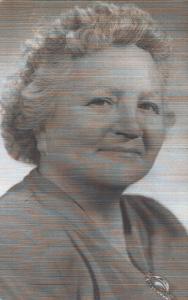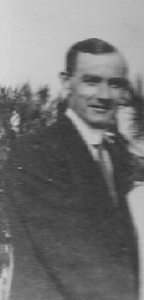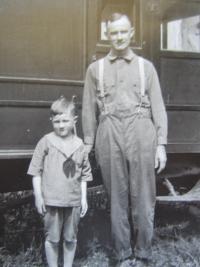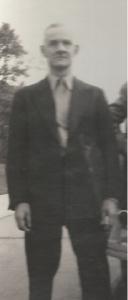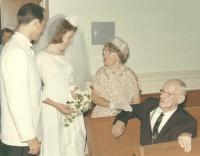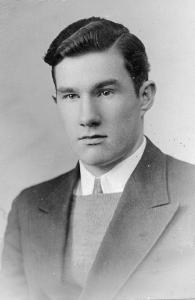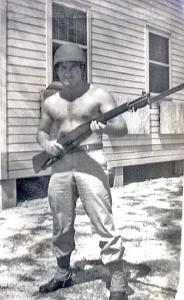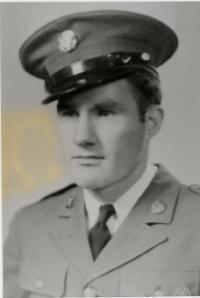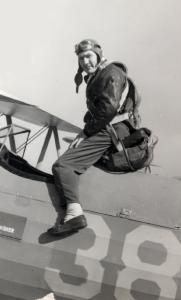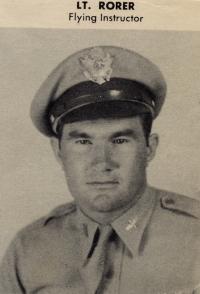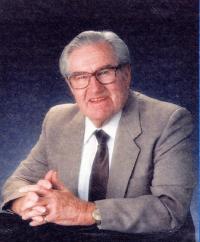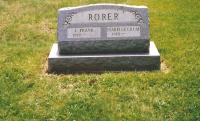Jennie Olive Nelson
F, #104, b. 27 November 1890, d. 10 July 1953
| Charts | Benjamin Crum Pedigree Chart Benjamin Crum Descendant Indented Chart |
| Father | George Nelson b. c 1864 |
| Mother | Anna D. Ruckman b. c 1870 |
| Birth* | 27 November 1890 | Jennie Olive Nelson was born on 27 November 1890 in New JerseyG.1,2 |
| 1900 Census | 20 June 1900 | She appeared on the 1900 Federal Census of 29 Somerset Place, North Plainfield, Somerset, NJG in the household of her parents, George Nelson and Anna D. Ruckman.3 |
| 1910 Census | 16 April 1910 | She appeared on the 1910 Federal Census of 29 Somerset Place, North Plainfield, Somerset, NJG in the household of her parents, George Nelson and Anna D. Ruckman.4 |
| Marriage* | She married Hawley Rittenhouse Crum, son of Joseph H Crum and Anna Maria Carter, sometime after the 1910 census was taken on 16 Apr 1910.5,4 | |
| 1920 Census* | 29 January 1920 | She and Hawley Rittenhouse Crum appeared on the 1920 Federal Census of Redondo, Los Angeles, CaliforniaG, enumerated 29 January 1920. Their children Richard Clifford and Robert Nelson were listed as living with them. Hawley owned the poultry ranch on which the family resided.1 |
| Census 1930 | 21 April 1930 | Hawley and Jennie appeared on the 1930 Federal Census of Inglewood Township, Los Angeles, CAG enumerated 21 April 1930. The family owned a radio. They also owned the poutry and egg ranch worth $20,000 on which they were living. Their children Richard Clifford, Robert Nelson, Ruth Anna and Phillip Norman were listed as living with them.6 |
| Death* | 10 July 1953 | She died on 10 July 1953 at Los Angeles, CAG, at age 62.2 |
Children of Jennie Olive Nelson and Hawley Rittenhouse Crum | ||
|
| Last Edited | 11 May 2016 |
Citations
- 1920 U.S. census, Los Angeles, CA, population schedule, E.D.536, p.16A, dwelling 427, family 429, Hawley R. Crum: digital image by subscription, Ancestry.com (http://www.ancestry.com) (4 May 2008): National Archives microfilm T625-118.
- California Death Index, 1940-1997, www.ancestry.com, accessed 10 Feb 2010.
- 1900 U.S. census, Somerset, NJ, population schedule, North Plainfield, E.D. 86, page 84, dwelling 399, family 435, George Nelson: digital image by subscription, Ancestry.com (http://www.ancestry.com) (accessed 13 Feb 2010): National Archives microfilm T623.
- 1910 U.S. census, Somerset, NJ, population schedule, North Plainfield, E.D. 118, page 2B, dwelling 37, family 47, George C. Nelson: digital image by subscription, Ancestry.com (http://www.ancestry.com) (accessed 31 Dec 2011): National Archives microfilm T624_908.
- Letter from Ruth Ent (Box 22, Sergeantsville, New Jersey) to Louise Rorer Rosett, 2 May 1978; in the files of Louise Rorer Rosett (1005 Stagecoach Rd SE, Albuquerque, NM). Ruth Ent copied birth, marriage and death information from the family Bible in the possession of Ruth Crum, daughter of Isaac Crum.
- 1930 U.S. census, Los Angeles, CA, population schedule, Inglewood Township, E.D. 19-1035, page 193, dwelling 585, family 586, Hawley R. Crum: digital image by subscription, Ancestry.com (http://www.ancestry.com) (accessed 13 Feb 2010): National Archives microfilm T626.
Henry J. Nykamp
M, #2547
| Charts | Benjamin Crum Pedigree Chart Benjamin Crum Descendant Indented Chart |
| Marriage* | Henry J. Nykamp married Beatrice Crum, daughter of Mahlon Frank Crum and Alice Venable.1 |
Children of Henry J. Nykamp and Beatrice Crum | ||
|
| Last Edited | 28 Feb 2016 |
Citations
- Beatrice Virginia Nykamp Obituary, The Express Times, Jersey City, NJ, 18 Sep 2010, www.genealogybank.com (accessed 28 Feb 2016).
Ralph Olivera
M, #2816
| Charts | Benjamin Crum Pedigree Chart Benjamin Crum Descendant Indented Chart |
| Marriage* | Ralph Olivera married Marian R. Crum, daughter of Henry Francis Crum and Lillian C. Babel.1,2 |
Family: Ralph Olivera and Marian R. Crum |
| Last Edited | 2 Apr 2016 |
Citations
- Obituary - Harry F. Crum Rites Monday, Trenton Evening Times, Trenton, NJ, 08 Dec 1967, page 9, www.genealogybank.com.
- Obituary - Mrs. Henry F. Crum, Trenton Evening Times, Trenton, NJ, 26 Jan 1959, page 4, www.genealogybank.com.
Harry Closson Rorer
M, #14, b. 18 March 1886, d. 27 January 1968
| Birth* | 18 March 1886 | Harry Closson Rorer was born on 18 March 1886 in Doylestown, Bucks, PAG.1 |
| Namesake* | Harry Closson Rorer was named for William Harrison Closson, his maternal grandmother's brother. | |
| Baptism | 26 August 1894 | Eight year old Harry was baptized on 26 August 1894 at St. Paul's Episcopal Church, Doylestown, Bucks, PAG. His sister, Lottie Bolton Rorer was baptized on the same day. Mrs. Rorer was Harry's sponsor; Mrs. Randall was the sponsor for Charlotte.2,3 |
| Event-Misc* | 13 November 1897 | "Harry Rorer, a pupil of the borough schools, was knocked down and run over by a team on State Street, Friday afternoon. The little fellow waked to the office of Dr. Swartzlander, Jr. where it was found only slight injuries had been sustained."4 |
| Marriage* | 1 March 1917 | He married Emily McGookin on 1 March 1917 at Philadelphia, PAG. He was thirty years old.5 |
| Draft registration* | 12 September 1918 | Harry registered for the draft on 12 September 1918 at Doylestown, Bucks, PAG. He was a self employed trucker, i.e., a farmer who raises crops and sells them door to door to city dwellers. Harry was of medium height, medium build with grey eyes and brown hair.6 |
| Census 1920* | 2 January 1920 | He and Emily McGookin appeared on the 1920 Federal Census of Pebble Hill Road, Doylestown TownshipG, enumerated 2 January 1920. Their son Frank was listed as living with them. Harry was a truck farmer working a rented farm on his own account. Harry's father, Frank, was living with the family and was employed as a truck farmer.7 |
| Census 1930* | 10 April 1930 | By 10 April 1930, Harry and Emily had moved to 132 Heck Avenue, Neptune Township, Monmouth, NJG. Their thirteen year old son Laurence Frank was living with them. The family was paying $38 in monthly rent for their home and had a radio. Harry was a printer working in a press office.8 |
| Census 1940* | 16 April 1940 | Harry and Emily and son, Frank, had moved again and appeared on the 1940 Federal Census of 111 Park Lane, Hamilton, Mercer, NJG, enumerated 16 April 1940. 54 year old Harry had completed eighth grade. He worked 48 hours a week as a printer for a hotel. He was paid $1020. 60 year old Emily had also completed the eighth grade but had not worked outside the home during the year. The family had been residing at this address in 1935.The rent paid was $31 per month.9 |
| Draft registration | 1942 | In 1942, 56 year old Harry registered for the "old man's" draft of World War II while residing at 111 Park Lane, Trenton, Mercer, NJG. He was a working as a printer for the Stacy-Trent Hotel.1 |
| Compiler's Comment | In those days, hotels employed a printer to print up new menus every day. | |
| Death* | 27 January 1968 | He died on 27 January 1968 at Mercer Hospital, Trenton, Mercer, NJG, at age 81.10 |
| Obituary* | 29 January 1968 | He's death was was recorded in an Obituary on 29 January 1968 in the Trenton Evening Times, Trenton, NJG. "Harry C. Rorer. YARDLEY - Harry C. Rorer, 81, of 11 Richie Lane died Saturday in Mercer Hospital after a brief illness. Born in Doylestown, Pa he had lived in Trenton and Titusville and resided here for six months. He was a retired printer. He is survived by his wife, Emily, one son J [sic] Frank of Yardley and four grandchildren. The funeral and interment will be private. Arrangements are under the direction of Charles Reed Funeral Home."10 |
| Burial* | 30 January 1968 | He was buried on 30 January 1968 at Doylestown Cemetery, Doylestown, Bucks Co, PAG, Section I2, Row 5, number 24.11,12 |
| Compiler's Comment* | According to the compiler's father, who was Harry's son, Harry had completed tenth grade. When comparing his education to that of his wife who completed eighth grade in Ireland, they determined that an eighth grade education in Ireland was equivalent to a tenth grade education in the U.S. Harry had to leave school to take a job and help support his family. His father got him an apprenticeship as a printer at the local newspaper. Harry's two best friends in school became the town physician and the newspaper editor. Mickey remembers that as a young boy walking down the street in Doylestown, if one of those two men was walking nearby, Harry would cross the street to avoid meeting these men. Mickey never understood why. Was Harry ashamed of the way his life turned out when compared to that of his two friends? Harry much preferred farming to being a printer. After he married, he rented a farm at Pebble Hill, outside of Doylestown, and started a truck farm. He raised his crops then drove them to Philadelphia neighborhoods and sold them from the back of his Ford truck. He had a very loyal group of customers until one mistake ruined his reputation. His corn was so well liked that he ran out before reaching the end of his route. He drove back to a neighboring farm in the Doylestown area and bought a load of corn from the farmer. Harry returned to his route and sold this corn. Unfortunately, the farmer sold him field corn, fit only as food for horses. Apparently, Harry was too trusting and naively assumed the farmer had sold him good quality corn fit for human consumption. Harry lost a lot of customers because of that. He had another problem. Emily had gone to work in NYC to earn some money to help with the farm expenses including buying materials to make cold frames. In the meantime, Harry's sister and brother had taken the exam to become the Doylestown Postmaster. His sister, Charlotte, received the highest score. His brother, Laurence, had the second highest score. Charlotte relinquished her claim on the position to her brother. Once in this position, Laurence was opening the mail to Harry from his wife, Emily, which contained money Emily was sending to Harry. Laurence was stealing this hard earned money. Rather than forcing Laurence to repay him, Harry gave up the farm and, in return, Laurence became responsible for taking care of their parents. Harry returned to the printing business and took a job at the Jersey Shore. He also opened a restaurant there but never made any money. He would buy a large roast for the weekend meal but Emily would invite all her friends and give them free meals.There was no way the restaurant could be profitable. Eventually Harry got a job as the purchasing manager at a hotel. This was a position he really enjoyed and apparently was very good at. Harry never lost his love for farming. After Emily and Harry moved to their large piece of land on Blue Ridge Road, Titusville, NJ, they always had a large garden. The compiler remembers picking strawberries and raspberries at their house as a child. |
Child of Harry Closson Rorer and Emily McGookin | ||
|
| Last Edited | 7 May 2018 |
Citations
- U.S., World War II Draft Registration Cards, 1942, online Ancestry.com (http://www.ancestry.com), (accessed 14 Feb 2016).
- Doylestown, PA,, Church records, 1846-1927 [St. Paul's Episcopal]: microfilm 1486647, Family History Library, Salt Lake City, UT.
- 26 Aug 1894, Baptismal Certificate, in the files of Louise Rorer Rosett, 1005 Stagecoach Rd SE, Albuquerque, NM.
- (no title), Doylestown Intelligencer, Doylestown, PA, 13 Nov 1897, courtesy of Paul Rorer.
- Philadelphia, Pennsylvania, Marriage Index, 1885-1951: Marriage license 359594, (accessed 8 Feb 2016), digital image by subscription, Ancestry.com (http://www.ancestry.com), Provo, UT.
- World War I Draft Registration Cards, 1917-1918, online Ancestry.com (http://www.ancestry.com), (accessed 14 Feb 2016).
- 1920 U.S. census, Bucks, PA, population schedule, Doylestown Township, E.D. 22, page 1A, dwelling 5, family 6, Harry C. Rorer: digital image by subscription, Ancestry.com (http://www.ancestry.com) (accessed 27 Feb 2013): National Archives microfilm T625_1542.
- 1930 U.S. census, Monmouth, NJ, population schedule, Neptune, E.D. 92, page 3B, dwelling 82, family 85, Harry C. Rorer: digital image by subscription, Ancestry.com (http://www.ancestry.com) (accessed 27 Feb 2013): National Archives microfilm T626, Family History Library microfilm 2341107.
- 1940 U.S. census, Mercer, NJ, population schedule, Hamilton Township, E.D. 11-17, page 10B, line 52, Harry Closson Rorer: digital image by subscription, Ancestry.com (http://www.ancestry.com) (accessed 7 Feb 2016):.
- Harry C. Rorer, Trenton Evening Times, Trenton, NJ, 29 Jan 1968, page 8, www.genealogybank.com.
- Vernon Althouse, compiler, Doylestown Cemetery, Spruance Library, 84 South Pine Street, Doylestown, Bucks, Pennsylvania.
- Cemetery Card File, Spruance Library, 84 South Pine Street, Doylestown, Bucks, Pennsylvania.
Laurence Frank Rorer
M, #1376, b. 26 June 1917, d. 9 July 1997
| Charts | Benjamin Crum Pedigree Chart Benjamin Crum Descendant Indented Chart |
| Father | Harry Closson Rorer b. 18 Mar 1886, d. 27 Jan 1968 |
| Mother | Emily McGookin b. 13 Sep 1879, d. 24 Sep 1976 |
| Birth* | 26 June 1917 | Laurence Frank Rorer was born on 26 June 1917 in Philadelphia, PAG.1 |
| Name Variation | He was named for his father's brother, Laurence, and for his paternal grandfather, Frank Rorer. He was never called by his first name. In formal situations, such as school, he was known as Frank Rorer. His friends called him Mickey, an affectionate nickname given to him by his Irish mother. | |
| Baptism | 7 October 1917 | He was baptized on 7 October 1917 at St. Stephen's Episcopal Church, 10th Street above Chestnut, Philadelphia, PAG.2 |
| Census 1920 | 2 January 1920 | He appeared on the 1920 Federal Census of Doylestown Township, an unknown place , in the household of his parents, Harry Closson Rorer and Emily McGookin.3 |
| Compiler's Comment | No mention was made of his grandmother, Augusta. She appears no where else in the census for 1920 so the omission was from the census for the household of Harry Rorer was probably an oversight. | |
| Census 1930 | 10 April 1930 | By 10 April 1930, Mickey and his parents had moved to 132 Heck Avenue, Neptune Township, Monmouth, NJG.4 |
| Occupation* | Mickey lived on a farm, Pebble Hill, Doylestown Township, Bucks County, Pennsylvania until he was about seven years old. The family moved to Ocean Grove, New Jersey, where he attended school. His family moved to Hamilton Township when Mickey was about 16 years old. He went to enroll at Hamilton High School for his senior year and produced his transcript from Neptune High School. His record included an "A" he had received in a course which was a senior year course at Hamilton High, called Problems of American Democracy. Mickey had taken this class prior to his senior year. The principal would not allow Mickey credit for this class, insisting an underclassman was not capable of dealing with the issues in that course. He insisted Mickey take the class again at Hamilton High School. Mickey was so disgusted that he walked out of the school and did not enroll for his senior year. It was not unusual, at that time, to go to work rather than complete high school. In 1940, more than three-quarters of those 25 and older had not graduated from high school; only 5% held a bachelor's degree or higher.5 Rather than enroll At Hamilton High School, Mickey took a job at a gas station down the street from where he lived. Isabelle Crum walked past this gas station every day on her way to her college classes. They began to say "hello", which evolved into conversations, which evolved into dating. Mickey bought the gas station from its owner. He also opened a used car lot. Around this time, and perhaps under the influence of college girl Isabelle, he realized he needed to finish high school. He enrolled at Trenton High, where he played football. This is when his second/false birth certificate was created showing a birth date of 1919, not 1917. Although he had not used his eligibility for high school sports, he was too old to play. He was not going to finish high school if he could not play football. His mother wrote a letter swearing that his birth date was 1919 not 1917 and had it notarized. From that point on, he told everyone, including the U.S. Army, that he had been born in 1919. | |
| Physical Description* | He was about 5'7" tall with broad shoulders and a strong upper body. His hair was dark, eyes blue and of very fair complexion. He was an excellent athlete playing football in the fall, basketball in the winter and was a hurdler in the spring. He also played semi-professional football in Doylestown, PA before the war. | |
| Marriage* | 1 January 1940 | He married Isabelle Maidie Crum, daughter of Grover Cleveland Crum and Mary Elizabeth Scott, on 1 January 1940 at Warrenton, Fauquier, VAG.6 |
| Compiler's Comment | Isabelle and Mickey kept their marriage secret. After the marriage license was issued, they returned to live with their respective parents. One of the main reasons their marriage was secret was because married women could not be employed as teachers. The public felt these jobs should be given to men who were supporting families, not to women who already had a wage earner in the home. Isabelle wanted to become tenured. She kept her marriage secret until she received tenure. | |
| Census 1940 | 16 April 1940 | He appeared on the 16 April 1940 Federal Census of 111 Park Lane, Hamilton, Mercer, NJG in the household of his parents. He had completed four years of high school. He was self employed at a filling station he owned. There was no information about the hours worked or the amount of income earned.7 |
| Military* | Mickey was drafted into the Army for one year of service. He reported for duty in February of 1941. Shortly before his one-year enlistment was to expire, the Japanese bombed Pearl Harbor. No one was released from the service after that terrible day. He was in the Fourth Division, Eighth Infantry and trained at Fort Benning, Georgia. The US was so unprepared for war that Mickey and his buddies were trained using wooden rifles; there were not enough guns available to give to the new recruits. Because he had owned his own gas station before being drafted, Mickey was assigned to the motor pool. Due to his leadership traits and extensive knowledge, he was quickly promoted to Sergeant. When he realized the war would not be over soon and he would be in the military for an unknown number of years, he applied to be a cadet in the Army Air Corps. Mickey was ambitious and always looking to move ahead. There were many bright, ambitious people like Mickey who had not had the opportunity for higher education. Recognizing this pool of talent, the Army started testing non-college graduates to become cadets. Mickey was in the first class of non-college graduates to be accepted into the aviation cadet training program. He must have been a heck of a pilot, because his assignment upon earning his wings in June, 1943, was to be a flight instructor. The Second Lieutenant felt guilty, however, that he was training young men to fly in combat when he had never been in combat. In addition, he was constantly harassed by his barber who kept reminding Mickey that his son was overseas fighting while Mickey had a safe job in the States. Mickey was also worried about the legacy he would leave his young daughter, Fran. He wrote in a letter (in the files of the compiler) that he wanted his daughter to be proud of him when she would ask him what he did in the war. He thought she would be much prouder if he had been overseas and involved in the fight to beat the Nazis than if he had sat safely in the U. S. So when the Army Air Corps asked for volunteers with the requisite hours of flying experience to learn to fly a new plane, Mickey volunteered. The new plane was the B-29, a huge four-engine bomber. But when he arrived in Tennessee for training, the B-29 wasn't quite ready. Instead of flying the B-29, he was assigned to the European theater as a B-24 bomber pilot. Mickey was irate. He had been trained as a fighter pilot. He had given up his job as a flight instructor in order to fly a cutting edge plane. He was not interested in flying the slow and steady bombers. Naturally, the Air Corps did not care about an individual's preferences. Mickey was no longer an instructor, there was a shortage of bomber pilots, and the Air Corps was going to turn Mickey into one. Mickey was so down he stopped trying to do his best while being trained in the B-24. His attitude was so poor that at one point he jeopardized his commission. Instead of heading to Italy in August, 1944, as a pilot, he was made a co-pilot. His stint as a co-pilot did not last long. The commanding officer of the 723rd squadron, 450th Bomb Group, 15th Air Force quickly realized Mickey was an outstanding pilot. Mickey was reinstated as a pilot. By January, 1945, he had been promoted to 1st Lieutenant. The commanding officer had so much faith in Mickey's ability to bring the plane back safely, that he became Mickey's co- pilot! In April, 1945, Mickey was promoted to Captain. Many of the men who had completed their tour of duty in Italy would ask Mickey to fly them to their embarkation point. These fellows were superstitious that they had survived the war, but would die on their flight to go home. They believed that if any one could get them on their way safely, it was Mickey. He flew 56 missions as a B-24 pilot in ten months. His commanding officer recommended Mickey be promoted to Major. The promotion was denied because Mickey had not been a Captain for a long enough period. He earned the Distinguished Flying Cross (DFC). It was awarded after he was able to safely land the plane after a spinning propeller tore off the bomb bay door which then tore through the horizontal stabilizer at the rear of the plane. That day the bombers had been lined up on the runway trying to set a record for the fastest take off. Unfortunately, the plane in front of him exploded and its propeller went spinning down the runway towards Mickey's plane. Mickey tried to steer his plane around the spinning propeller using the flaps and speed of the engine (B-24's did not have a steering wheel.) Initially, he refused to accept the Distinguished Flying Cross because somebody in his outfit was getting a Purple Heart for scratching his finger on the bomb bay door. He argued that awarding a medal for that little scratch devalued all the awards and so he didn't want the DFC. His commanding officer ordered him to accept the award or he would be subject to a court martial. In conversations with the compiler held many years after the war, Mickey said that the DFC was really for an accumulation of actions. The only one he mentioned was the time he was flying on a bomb run when the lead plane was shot down. The lead plane contained the lead navigator and bombardier that the other planes tracked to know when to release their bombs. He got on the radio and organized the remaining planes into a formation so that they could continue the mission. When discussing medals, he mentioned the British had to do something really spectacular and heroic to receive a medal. Mickey felt that the U.S. handed out awards like candy. During one bombing run, the crews were impressed by the ferocious protection provided by their fighter escort. After returning to base, the pilots requested that fighter squadron on all their missions. It was then that they learned those planes were piloted by Negroes (the terminology used in that period.) Coming from a segregated society, it was eye opening for the flyers of the 450th Bomb Group to realize their best fighter escorts were Black. Mickey later compared notes with these African-American airmen, who had graduated from cadet training held at the Tuskegee Institute in Alabama (thus their moniker of the Tuskegee airman). Mickey was impressed to learn that the Black pilots under went much more rigorous training than their white counterparts. See www.450thbg.com/real/biogrpahies/rorer/rorershtml for more of his military records. | |
| Misc* | 9 September 1942 | On 9 September 1942 he designated his father, Harry C. Rorer, 111 Park Lane, Trenton, NJ, the beneficiary of his $10,000 VA life insurance policy. His wife was upset when she found out.8 |
| Compiler's Comment | Perhaps he was thinking that Isabelle could always pursue her career as a teacher as they did not have any children at the time. | |
| Marriage | 15 April 1943 | He married Isabelle Maidie Crum for a second time on 15 April 1943 at Phoenix, AZG.9 |
| Compiler's Comment | Isabelle had now received tenure. She took a leave of absence so she could join Mickey in Phoenix, AZ where he was an Army Air Corps cadet. Air Corps cadets were not allowed to be married while they were in training. As soon as many of the cadets received their wings, they married their sweethearts. Mickey and Isabelle followed this pattern. Their second marriage was announced to family and friends. | |
| Occupation | Mickey had spent five years in the military. Now the war was over. What next? Isabelle and Mickey loved California and talked about settling there. But Mickey was an only child and felt responsible for his parents. He knew they would never move to California, so Isabelle and Mickey returned to New Jersey. Isabelle offered to go back to teaching so Mickey could attend college using the GI Bill. (Fearful of the consequences if the returning veterans could not assimilate into the economy, Congress passed "The Service Members' Readjustment Act of 1944", commonly known as the GI Bill of Rights. The bill provided a living allowance and tuition waiver for those returning to school. It also provided loan guarantees so veterans could buy a home, farm or business.) 10 Pilot training had given him junior standing at University of California, Los Angeles (UCLA.) But Mickey felt it was his responsibility to support his wife and child. Instead, he painted houses with his father-in-law and opened a parking garage across from the train station in Trenton. The veteran was not satisfied! When Mickey was a teen-ager, he had worked for J.J. Conroy at his Ford Dealership in Doylestown, Pennsylvania. The ambitious young man had always dreamed of owning his own Ford dealership. J.J. Conroy helped Mickey realize his dream. Conroy loaned him money so Mickey could buy a Ford dealership in Sellersville, Pennsylvania. Mickey became the youngest dealer in the U. S. and was featured in a Ford advertisement in Life Magazine. His dealership was so successful that he moved the dealership to a larger facility in Quakertown, a few miles north of Sellersville. The dealership was called Sell-Perk Ford for the towns of Sellersville and Perkasie. When Ford threatened to put a dealership in Perkasie, Mickey opened a branch in that town. He also owned a used car lot in Allentown, Pennsylvania. Mickey, however, was unhappy in Quakertown. He provided excellent service to his customers (such as giving people loaner cars when their car was in the shop, an unheard of practice then), but the local people did not appreciate it. If they could get a car $10 cheaper down the road, they would buy their car there. He also felt that the provincial nature of the small town was not a good place to raise his daughters. He sold his dealership and moved back to the Trenton area. The only new car dealership available at the time was with Studebaker-Packard. Isabelle thought he should open used car lot and wait for a different franchise to become available. Although he knew he was taking a gamble, he bought the Studebaker-Packard franchise. Mickey became the number one dealer in the country. Studebaker-Packard awarded another dealership to someone in Princeton, which cut into Mickey's market. During this time, he was offered a Mercedes-Benz franchise. The war was still fresh in his memory; he would not sell a product produced by the people who were trying to shoot him out of the sky a decade earlier. About eight years after buying the dealership, Mickey sold it at a huge loss. Studebaker-Packard went bankrupt shortly after the sale. He found a job at Reedman Motors in Langhorne, Pennsylvania, one of the first dealers to have multiple franchises under one roof. As he had done his entire life, he quickly rose to the top and was made general manager. | |
| Compiler's Comment* | He had contracted colon cancer about two years before his death. Six weeks before he died, he suffered a massive stroke. He could no longer reason clearly or speak intelligently. He was able to put together several phrases, one of which was "I want read." Reading had become his major past time as he suffered from debilitating arthritis. With his family gathered around him, he kept repeating "I lucky, I lucky". He knew how fortunate he was that, in spite, of the drinking, his family stood by him. He passed away with Fran and Louise holding his hand. | |
| Death* | 9 July 1997 | He died on 9 July 1997 at Kaseman Hospice, Albuquerque, Bernalillo, New MexicoG, shortly after his 80th birthday.11 |
| Burial* | 11 July 1997 | He was buried on 11 July 1997 in the veterans' section of Vista Verde Memorial Park, Rio Rancho, New Mexico.11 |
| Compiler's Comment | Mickey was well liked by everyone who met him. He worked extremely hard and never complained. He was also highly intelligent. As just one example, he had the highest score in the state of Pennsylvania on an insurance license exam even thought he was not in the business of selling insurance. Unfortunately, for those who loved him, he had a weakness: he drank too much. This love of alcohol was encouraged in the Air Corps by the flight surgeons. They would meet the planes after a bomb run and give everyone a shot of whiskey to settle their nerves. Mickey enjoyed Manhattans and beer after the war. Although he never missed a day of work and always provided well for his family, he drank more and more through the years. Was it his Irish heritage, his upbringing, the stress of the war, the frustration with the Studebaker-Packard franchise or his way to treat a biochemical imbalance? It is not easy to pin alcoholism on any one factor, but Mickey had a serious problem. When he retired to Albuquerque, he was treated with anti-depressants. Isabelle noted a positive change in his personality when he took his medication. When he was younger, there wasn't any medication to treat depression. If there had been, perhaps he would not have had to use alcohol to deal with his emotions. It is interesting to note that Mickey played a lot of sports in his youth. When he returned from the war, he spent his spare time driving in car races in the modified stock division. (At one point he was ranked second in the nation.) Was he looking for a surge of endorphins to combat a biochemical deficiency? Whatever the cause, around 1982, he entered an alcohol rehabilitation program. He spent six weeks at an alcohol and substance abuse facility outside of Denver. After he returned home, he never took another drink. The compiler has discovered while doing family history research that the descendants of Jacob Rorer and Sarah Street seemed to have a high incidence of alcoholism and depression. Read the stories of the children and grandchildren of William and Edward for hints of these problems. Depression and addiction continues to follow some Rorer descendants down to the present generations of the compiler's family. |
Children of Laurence Frank Rorer and Isabelle Maidie Crum | ||
|
| Last Edited | 7 May 2018 |
Citations
- Lawrence [sic] F. Rorer, Certification of Birth 21342-R (11 Jul 1917), in the files of Louise Rorer Rosett, 1005 Stagecoach Rd SE, Albuquerque, NM.
- (photocopy of original), Baptismal Certificate, (7 Oct 1917), in the files of Louise Rorer Rosett, 1005 Stagecoach Rd SE, Albuquerque, NM.
- 1920 U.S. census, Bucks, PA, population schedule, Doylestown Township, E.D. 22, page 1A, dwelling 5, family 6, Harry C. Rorer: digital image by subscription, Ancestry.com (http://www.ancestry.com) (accessed 27 Feb 2013): National Archives microfilm T625_1542.
- 1930 U.S. census, Monmouth, NJ, population schedule, Neptune, E.D. 92, page 3B, dwelling 82, family 85, Harry C. Rorer: digital image by subscription, Ancestry.com (http://www.ancestry.com) (accessed 27 Feb 2013): National Archives microfilm T626, Family History Library microfilm 2341107.
- "FACTS", Wall Street Journal (25-26 Mar 2006).
- Laurence F. Rorer and Isabelle M. Crum Certificate of Marriage, in the files of Louise Rorer Rosett, 1005 Stagecoach Rd SE, Albuquerque, NM.
- 1940 U.S. census, Mercer, NJ, population schedule, Hamilton Township, E.D. 11-17, page 10B, line 52, Harry Closson Rorer: digital image by subscription, Ancestry.com (http://www.ancestry.com) (accessed 7 Feb 2016):.
- Laurence Frank Rorer National Service Life Insurance, 9 Sep 1842, in the files of Louise Rorer Rosett, 1005 Stagecoach Rd SE, Albuquerque, NM.
- Laurence Frank Rorer and Isabell [sic] Maidie Crum marriage, in the files of Louise Rorer Rosett, 1005 Stagecoach Rd SE, Albuquerque, NM.
- The GI Bill, www.gibill.va.gov/GI Bill Info/history.htm : accessed 19 July 2006.
- Laurence Frank Rorer, death certificate 803458 (14 Jul 1997), Bureau of Vital Records and Health Statistics, Santa Fe, New Mexico. Hereinafter cited as death cetificate.
